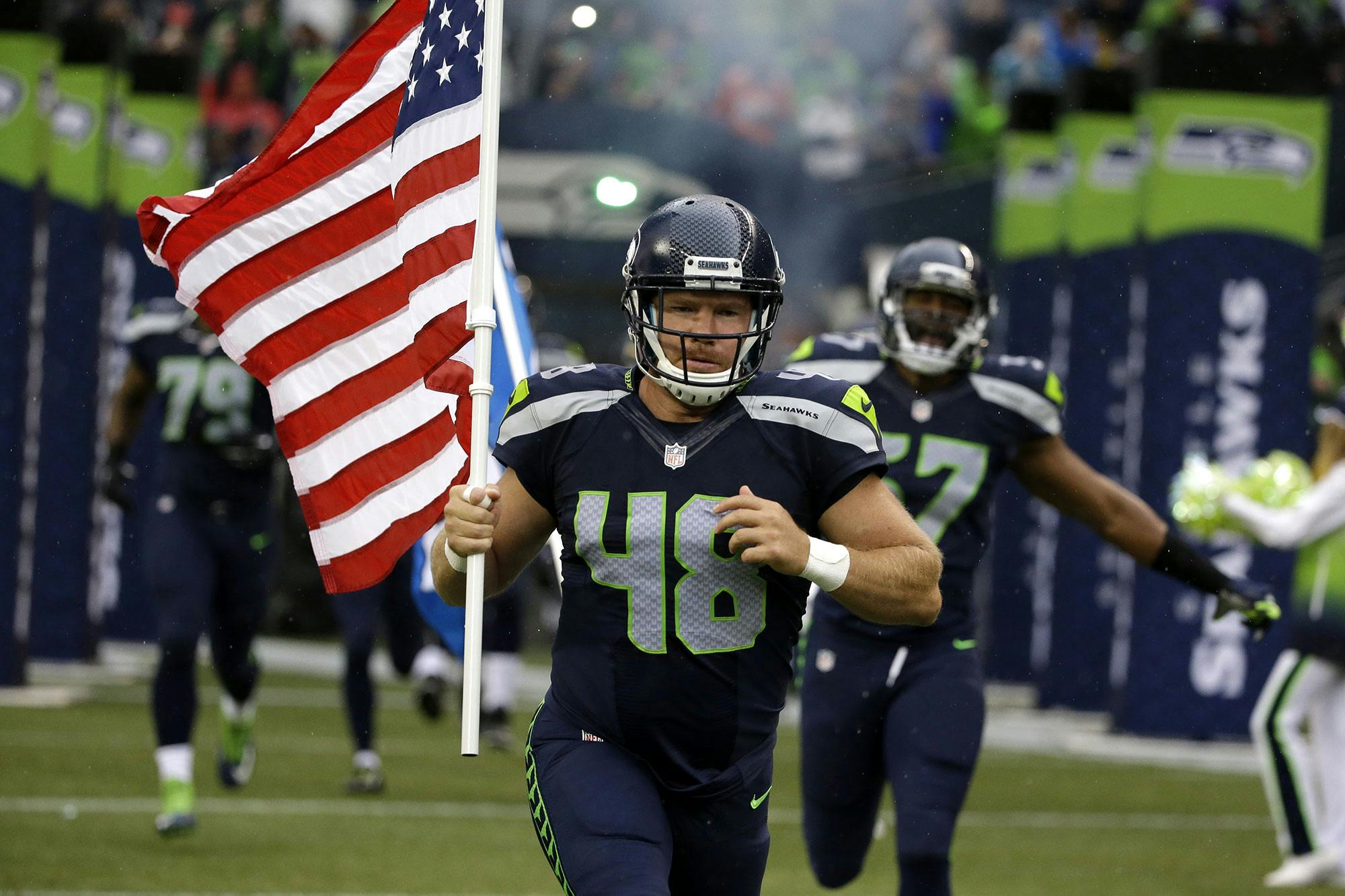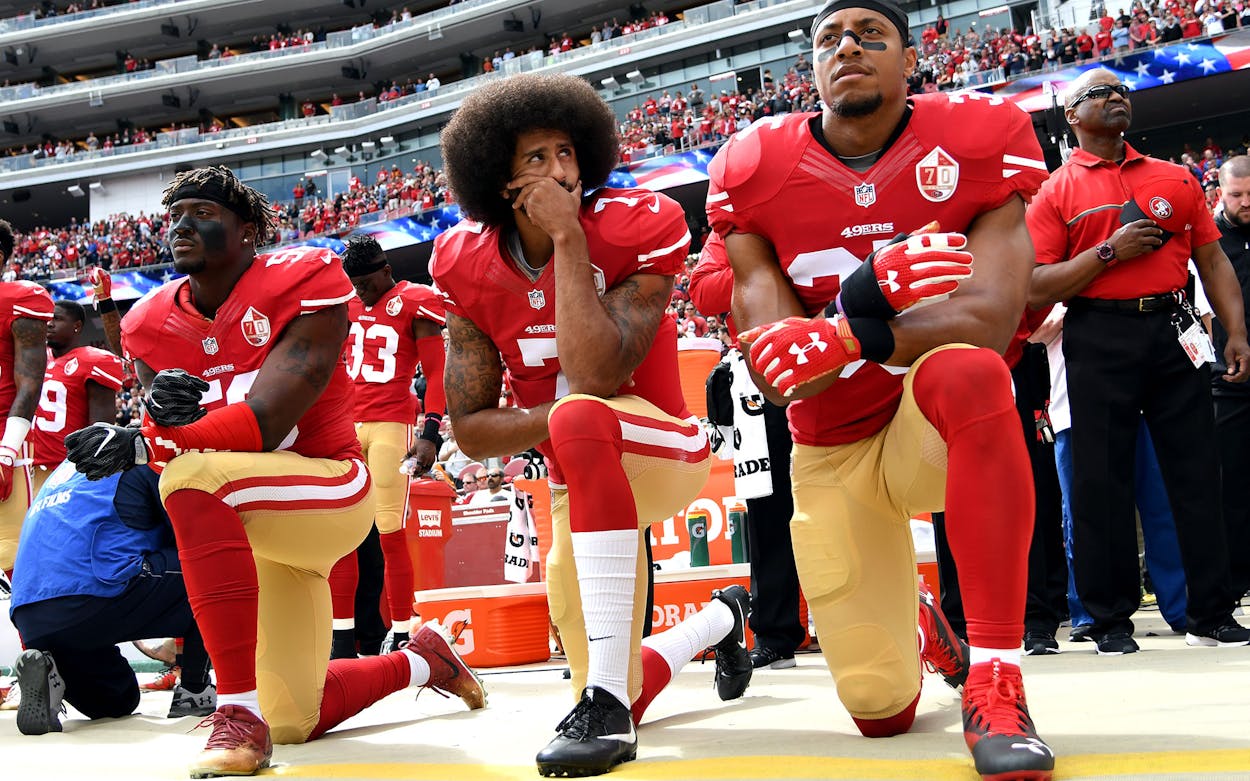This weekend, the issue of NFL players demonstrating during the national anthem took on renewed significance. President Trump, first in a speech on Friday, and later via Twitter, took aim at the league a few times—targeting the league’s ratings, the rule changes intended to avoid critical brain injuries, and the protests started by former San Francisco quarterback Colin Kaepernick that led NFL players to kneel silently during the anthem, in protest of race-based policing in America.
Trump, speaking in Alabama on behalf of U.S. Senator Luther Strange, opined to the crowd:
Wouldn’t you love to see one of these NFL owners, when somebody disrespects our flag, to say, “Get that son of a bitch off the field right now. Out. He’s fired. He’s fired!” You know, some owner is going to do that. He’s going to say, “That guy that disrespects our flag, he’s fired.” And that owner, they don’t know it. They don’t know it. They’ll be the most popular person, for a week. They’ll be the most popular person in this country.
So far, no owner has taken Trump up on his challenge. (Greg Abbott tweeted in August about a fabricated quote from Cowboys owner Jerry Jones, whose actual statements about protests during the anthem have been less strident.) But the NFL reacted on Sunday to the president’s attacks on the league and its players. Commissioner Roger Goodell responded with a statement, as did many NFL team owners—and the players themselves reacted with renewed protest. Almost the entire Oakland Raiders team sat or kneeled during the anthem, and the Pittsburgh Steelers (with the exception of offensive lineman Alejandro Villanueva, an Army vet) remained in the locker room, with head coach Mike Tomlin explaining that he wanted to avoid a situation in which some players demonstrated while others remained standing. The Seattle Seahawks did the same, with a team statement that went even further:
As a team, we have decided we will not participate in the national anthem. We will not stand for the injustice that has plagued people of color in this country. Out of love for our country and in honor of the sacrifices made on our behalf, we unite to oppose those that would deny our most basic freedoms. We remain committed in continuing to work towards equality and justice for all.
Many within the NFL—and the league itself, which cut together an ad in the wake of Trump’s remarks—spent less time addressing the original cause of the protests, which Kaepernick specifically intended as a response to “a country that oppresses black people and people of color,” and more on the broader cause of “unity.” Some teams, including the Houston Texans, demonstrated by having the entire roster link arms, often with the team owner among them, in a demonstration of that unity.
Trump, for his part, decided that he approved of the arm-linking gesture. It should be noted that Patriots quarterback Tom Brady—with whom the president maintains a friendship—participated in that specific demonstration in New England.
Great solidarity for our National Anthem and for our Country. Standing with locked arms is good, kneeling is not acceptable. Bad ratings!
— Donald J. Trump (@realDonaldTrump) September 24, 2017
The idea that “kneeling is not acceptable” is curious, though, given its origins. When Kaepernick began protesting the national anthem during the 2016 preseason, he did so by remaining seated on the bench while his teammates stood. The gesture initially went ignored, until a reporter asked him about it; at that point, he expressed that he intended it as a statement about institutional racism in the United States.

Nate Boyer, a Green Beret who played college football at the University of Texas at Austin as a long snapper (and who spent a few 2015 preseason games with the Seahawks), reacted to Kaepernick’s protest by penning an open letter to the quarterback. In the letter, Boyer explained why he was upset at the sight of Kaepernick on the bench during the anthem:
The only time I got to stand on the sideline for the anthem was during my one and only NFL preseason game, against the Denver Broncos. As I ran out of the tunnel with the American flag I could feel myself swelling with pride, and as I stood on the sideline with my hand on my heart as the anthem began, that swelling burst into tears.
I thought about how far I’d come and the men I’d fought alongside who didn’t make it back. I thought about those overseas who were risking their lives at that very moment. I selfishly thought about what I had sacrificed to get to where I was, and while I knew I had little to no chance of making the Seahawks’ roster as a 34-year-old rookie, I was trying.
That moment meant so much more to me than even playing in the game did, and to be honest, if I had noticed my teammate sitting on the bench, it would have really hurt me.
Prior to the start of the 2016 NFL regular season, Kaepernick and Boyer met to discuss the anthem protest. As a result of that meeting, Kaepernick stopped sitting on the bench during the anthem. Instead, he adopted a new, but now well-known, gesture: taking a knee as most of his teammates stood alongside him. One of Kaepernick’s teammates, safety Eric Reid, joined him in kneeling during the anthem. In an op-ed for the New York Times published Monday afternoon, Reid explained that Boyer changed his and Kaepernick’s minds about the specific pose used in protest. “We chose to kneel because it’s a respectful gesture,” Reid wrote. “I remember thinking our posture was like a flag flown at half-mast to mark a tragedy.”
Dropping to one knee, in most settings, is seen as a respectful gesture. In religions around the world, people kneel during prayer; it’s widely considered a symbol of reverence in almost any setting—except when it has happened during the national anthem at a sporting event in the past year. When people, including the president, declare that players who take a knee during the anthem are disrespecting the troops, the flag, or the country, they’re speaking out against a gesture that a Green Beret helped popularize.
Monday night, the Dallas Cowboys play against the Arizona Cardinals on Monday Night Football, and though Jerry Jones has not vowed to fire any player who protests, he’s expressed disapproval of demonstrations that occur during the anthem. (“I like the way the Cowboys do it,” he said, seemingly claiming the gesture of standing for the “Star Spangled Banner” for his team.) But according to the Fort Worth Star-Telegram, unnamed players on the team are planning to protest.
So far, the Cowboys are one of just six NFL teams who haven’t had a player kneel, sit, or raise a fist in protest. But until this past weekend’s games, that number was twice as large. The details of what Cowboys players may be planning are vague: according to the Star-Telegram, “it may just be a few individuals.” But if men wearing stars on their helmet take a knee on the sideline during the national anthem this evening, they’ll be participating in a gesture that—with the input of a Texan with experience in both the military and the NFL—evolved specifically as a way to both respect the military and protest how the nation fails to adhere to ideals for which Americans serve. As players continue to demonstrate, the reasons why they take a knee shouldn’t be lost.








